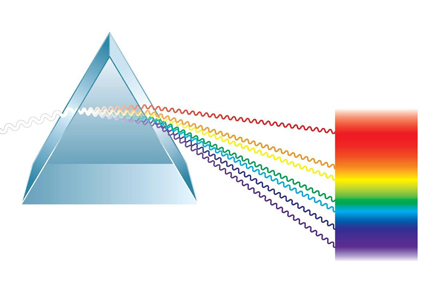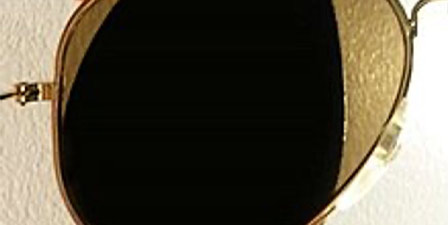
By Rebecca Soto, ABOC, NCLEC
Prism can be created in single vision lenses by manually decentering a single vision stock lens versus ordering the prism surfaced into a lens at a lab. As we know, a prescription will specify the amount of prism and the base direction of the prism. Prism base direction in a simple prism consists of a base in and base out, base up and base down. Prism is a transparent medium that deviates light and shifts or displaces the perceived location of the image. Prism does not focus light. Prism consists of an apex and a base. All lenses are, in essence, prisms with bases joined in the center or apices joined in the center. Plus lenses are joined base to base in the center while minus lenses are joined apex to apex at the lens center. When looking through the optical center of a lens, light is undeviated and no displacement of the image occurs. When a patient looks through an area other than the optical center of the lens, the image is displaced toward the apex of the prism. The prismatic effect a patient will experience when looking at an area outside of the optical center depends on the distance from where the patient is looking to the optical center of the lens and the power of the Rx. The further from the optical center, the eye and the higher the power of the lens, the greater the prism experienced.
The formula used to calculate the amount of prism is called Prentice’s Rule. The formula for Prentice’s Rule is: Prism (diopters) = Power (diopters) X Decentration (centimeters).
Prentice’s Rule can be used to create prism in a lens. As opticians, we are trained to optimize a patient's vision. We must make sure the optical center of a lens aligns with the patient’s visual axis. If the optical center of a lens is not aligned with the visual axis, then the patient is looking through prism. This is useful when we want to create prescribed prism by decentering a lens. Note: The following only applies to spherical single vision stock lenses with a simple prism with one base direction.
Prism can be created by decentration rather than surfaced. This can save time and money. Two important things to remember. You need enough lens power and you must determine the minimum blank size plus the amount of decentration to ensure cutout. Always check it in the lensometer using the prism reticle line to position the OC. Lens power must be greater than the prism power. Think about when you are marking a lens in the lensometer before edging. You want to make sure it is in the reticle. Think about how little movement it takes to decenter a lens with a power of -8.00 versus a lens power of -0.25. Not too many of us carry stock lenses as high as -8.00 but this is for illustration purposes.
Example: A -9.00 D lens, 1 diopter of prism.
To calculate decentration from Prentice’s Rule: Prism = Power X Decentration
1 = 9.0 X Decentration
To solve: Prism ÷ Power = Decentration
1 ÷ 9 = .11 cm or 1.10 mm (centimeters X 10 = millimeters)
Therefore, a -9.00 lens needs to be moved 1.10 mm from the patient PD to create 1 diopter of prism for the wearer.
Now a -1.50 diopter lens, 3 diopters of prism.
3 = 1.50 X Decentration
To solve: 3 ÷ 1.50= 2 cm or 20 mm
Therefore, a -1.50 diopter lens would need to be moved 20 mm to create 3 diopters of prism, and now the blank size comes into consideration. How likely is it that the lens will still cut out if the center is moved 20 mm from the patient PD location in the lens?
The base direction is another consideration when creating prism and depends upon whether the lens is OD or OS and whether it is a plus or a minus lens. Horizontal prism, base in or base out, uses the power at the 180◦ meridian in the Prentice Rule formula to calculate decentration needed to induce the required amount of prism. If a -9.00 D right lens with 1 diopter base-out prism is indicated, then the lens optical center will move inward to induce base-out prism. A +9.00 lens would need to be moved outward to create 1 diopter of base out prism in the right lens.
Vertical prism, base up or base down, uses the power at the 90◦ meridian in the Prentice Rule formula. Using the -9.00 D lens, to create base up prism decenter it down. For a +9.00 D lens, decenter it up. Do the reverse for base down prism. Note: We will address decentering for prism in cylindrical lenses in a future article. And while it is possible to decenter lenses to create compound prism (i.e. 3 BO, 2 BD), it requires more complex calculation that is better left to a surfacing lab.
As described, a lens with more dioptric power can be manually decentered to create prism. Looking at the examples above, we can see it is easier to induce prism in a lens with more dioptric power. Next time you are working in the lab, try it. Take a stock lens, determine an amount of prism and base direction. Then move the dotted center of the lens in the lensometer reticle the calculated number of millimeters from the position of the patient PD, verify and mark the prism. This could save your practice time and money in the future.
For an introduction to prism optics in ophthalmic lenses, go to our CE, The Spectrum of Prism Optics – Part 1 at 2020mag.com/ce.













